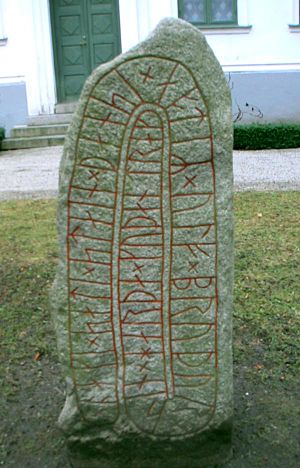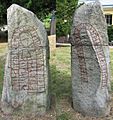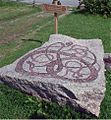Runestone facts for kids
A Runestone is a big stone with special carvings called runes. These stones were made a very long time ago, during the early Middle Ages. This was a time between the 5th and 15th centuries.
Today, we know of about 6,000 runestones. Most of them are found in Scandinavia. This area includes countries like Sweden, Norway, and Denmark. About half of these stones are from the 900s and 1000s. Many of them were found in Sweden.
Most runestones are like old grave markers. They tell us about the life and death of someone from that area. About one in ten runestones tells stories of people who traveled far away. Some of these stories are similar to what Scandinavian travelers wrote in Latin when they visited Byzantium. Byzantium was a powerful empire in the past.
Contents
What Are Runestones?
Runestones are ancient stones with messages carved into them. These messages use a special alphabet called runes. People in Northern Europe used runes for writing a long time ago. Runestones are like historical records made of stone. They give us clues about the past.
Where Were Runestones Made?
Most runestones come from Scandinavia. This region includes countries like Sweden, Denmark, and Norway. Sweden has the most runestones, with thousands found there. They are an important part of Scandinavian history.
When Were Runestones Made?
Most runestones were carved during the Viking Age. This was a period from the late 700s to the mid-1000s. The 10th and 11th centuries were when most runestones were created. This was a time when Vikings explored and settled new lands.
What Do Runestones Say?
Runestones often tell us about people and their lives. Many stones remember someone who had died. They might say who the person was and who set up the stone.
Some runestones tell exciting stories:
- They might talk about brave warriors.
- They can describe long journeys to faraway lands.
- Some stones mention battles or important events.
A small number of runestones show images. These pictures can be of animals, people, or symbols. For example, some stones show Thor's hammer. This is a symbol from Norse mythology.
Images for kids
-
An early runestone: the Möjbro Runestone from Hagby (first placed near Möjebro), Uppland, Sweden. As with other early runic inscriptions, (e.g. Kylver Stone from about 300–400 CE) this is written from right to left, while later Runestones were written from left to right. The text is "Frawaradaz anahaha is laginaz".
-
The Snoldelev stone, one of the oldest runestones in Denmark
-
Piraeus Lion drawing of curved lindworm. The runes on the lion tell of Swedish warriors, most likely Varangians, mercenaries in the service of the Byzantine (Eastern Roman) Emperor.
-
The Kingittorsuaq Runestone from Greenland
See also
 In Spanish: Piedra rúnica para niños
In Spanish: Piedra rúnica para niños

















